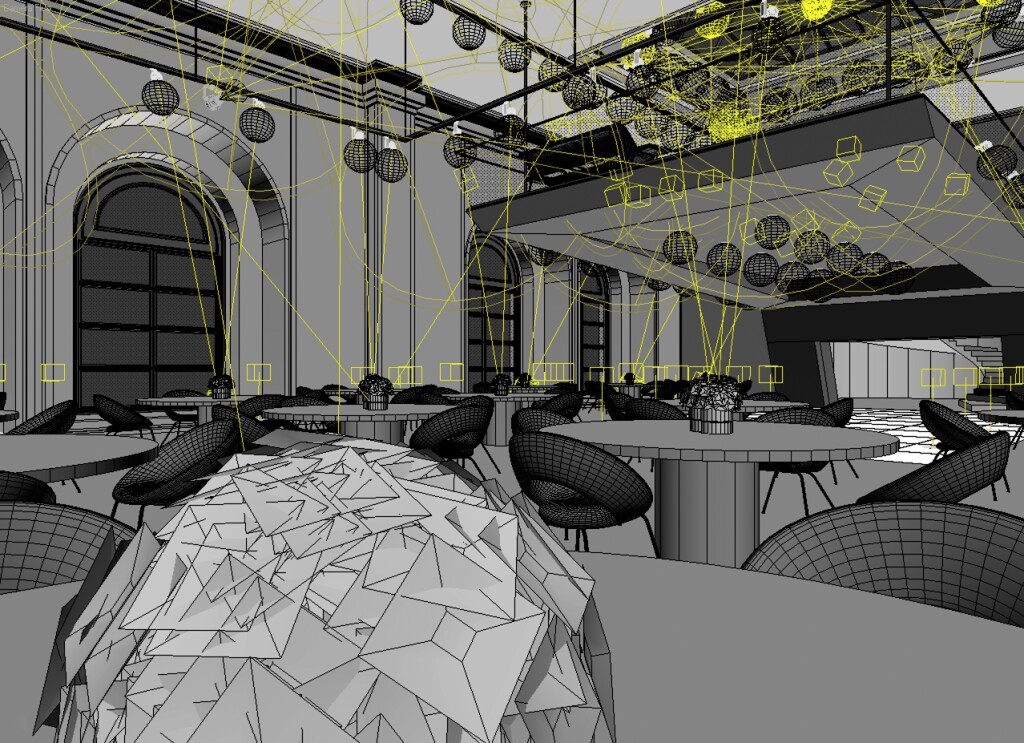
In recent years the use of CAD and simulation programs has resulted in a new understanding of light in architecture. The drawing board and its lamp have given way to the self-illuminating monitor. The result is that concepts in architecture are now made of light from the very first mouse click. In the visualisation process, luminous space now predominates.
However, this begs the question: has the luminous impression (part and parcel of the perfect, rendered setting) become more important than the engineering or architectural concept itself? With the improved interplay of shades, contrast, and brilliance, can lighting actually obscure the point of a realistic simulation?
More Light Matters, after the break…

While shades of sunlight can be illustrated in sketches with relative ease, imagining the interaction of multiple light sources in a space quickly becomes difficult. Thus, before the new millennium, architectural plans used to be displayed without indirect light due to a lack of hardware resources.
However, modern rendering engines can now clearly display daylight as well as incorporate indirect illumination interacting with surfaces, generating images with photographic realism. Furthermore, virtual luminaires (lighting fixtures) with photometric data offer the option to calculate illumination with physical accuracy, which allows for precise quantitative analysis in addition to aesthetic decisions. But even with the most sophisticated rendering engines, the qualitative results have their limits.

Although the more recent High Dynamic Range (32-bit/HDR) format offers a greater scope of contrast than previous processes with 8-bit and 255 gradations and theoretically covers the full luminance range of Nature (in which the sun is 10,0000 times brighter than a shaded zone), the perception of a perfect HDR rendering in print or on screen still does not fully compare to the atmospheric impression of a real, bright space, because image media currently cannot transmit factors such as glare or adaptation.

Thus, the advent of digital media has not only increased the speed of image production but has also given rise to new, though initially unconsidered, understandings of and ways of using light – as dictated by the characteristics (and limitations) of hardware and software. In particular, two distinct approaches towards visualization have emerged: on the one hand, scientific engineers who are mainly interested in quantitative data analysis in order to ensure a technically correct construction; on the other, Visionary Designers, who seek a subtle or impressive atmosphere with light. They develop a quality of light without any technical restrictions and ”cheat” with details in order to convincingly communicate an idea to a client. Even if this approach is less committed to reality, it can nevertheless stimulate the imagination and become a valuable tool in innovative designs.

For Jeremy Birn, a lighting technical director at Pixar Animation Studios, “cheating” with light occurs on a daily basis: “Cheating is performed, to some extent, on almost every project done in 3D. ... Light on a character that appears to come from a lamp may actually come from a position far away from the lamp if it lights a character better.” For Jeremy, lighting and cinematography are arts and not sciences. No matter the lighting style, it only matters that the light be believable to the viewer. Thus, the most important requirement is that the image be internally consistent, e.g. showing a beam of direct sunlight brighter than the light of a task light or forming a shadow correctly.
Of course, the challenge for architecture starts when a client is keen on the imaginative visualisation and then asks the architect to make the concept a reality.
However, even still, perhaps the “cheat” is better than the alternative. For example, video visualizations have become more and more relevant in architecture, and yet the technology often wields unsatisfying results, as rendered films with a high degree of realism (in terms of indirect light and reflection) are difficult to produce; the spatial dynamics for precise lighting simulations require considerable computer power.
In the case of the Graz Art Museum by realities:united, an abstract project which utilizes a complex video mapping technique on the facade, the visualization was severely limited to a flat treatment of the pixel façade that excluded indirect lighting and reflections. The GreenPIX simulator by Simone Giostra & Partners and ARUP similarly reduced realistic lighting details for the benefit of a faster rendering process. The NIX project study by realities:united, on the other hand, although not particularly naturalistic in all lighting details, at least allowed a dynamic impression and different perspectives that vividly demonstrated the interaction between the interior lighting and the effect on the urban environment.
And so, perhaps “cheating” is a preferable alternative, one that more accurately conveys the intent of the project, rather than letting the project fall flat. What is your opinion? Is it OK if you cheat with the lighting in architectural renderings? Do lighting simulations need to be accurate from the early concept up to working drawings? Or is some artistic and atmospheric leeway preferred? Please share your view in the comments below.
For further reading:
- Birn, Jeremy: Lighting & Rendering. New Riders, Berkeley. 2006.
- Ochoa, C.E., Aries, M.B.C. & Hensen, J.L.M.: State of the art in lighting simulation for building science: a literature review. Journal of Building Performance Simulation, 5(4), Pp. 209–233. 2012.
- Groß, Axel: Animation and digital lighting. PLD 2nd Global Lighting Design Convention, Berlin. 2010.
Light matters, a monthly column on light and space, is written by Thomas Schielke. Based in Germany, he is fascinated by architectural lighting, has published numerous articles and co-authored the book „Light Perspectives“. For more information check www.arclighting.de or follow him @arcspaces

